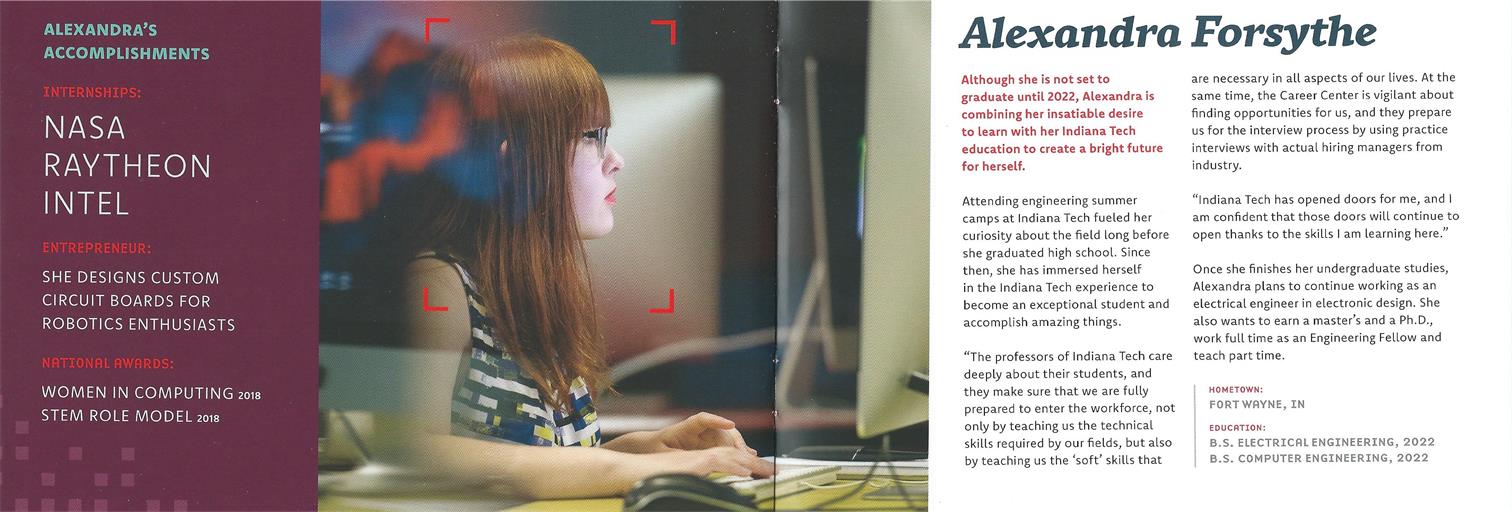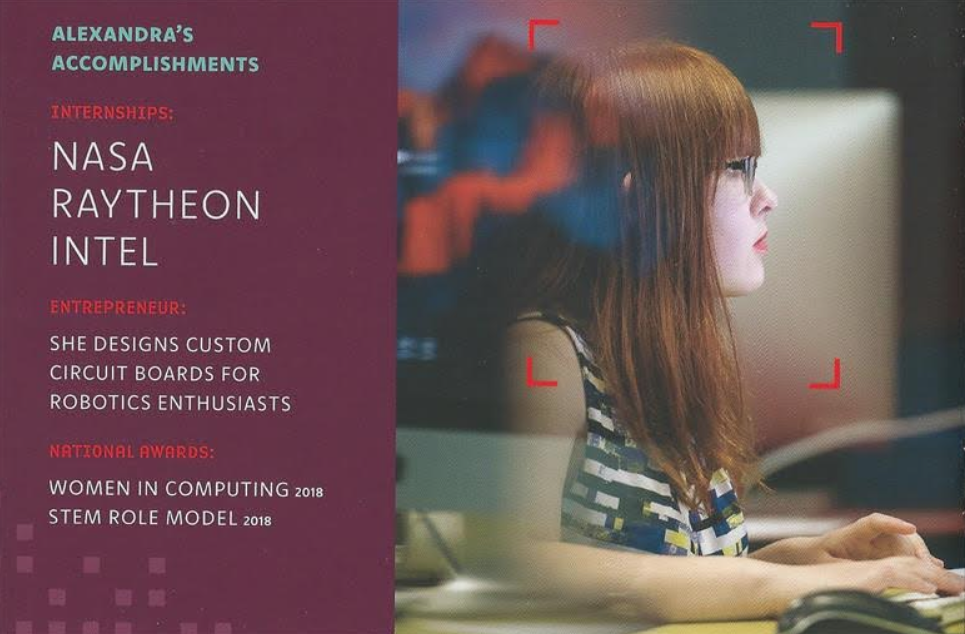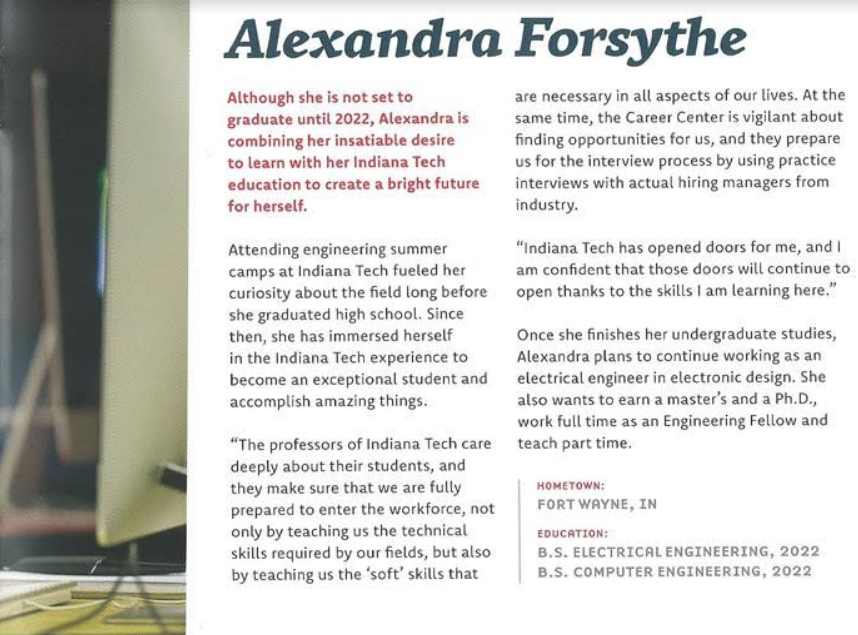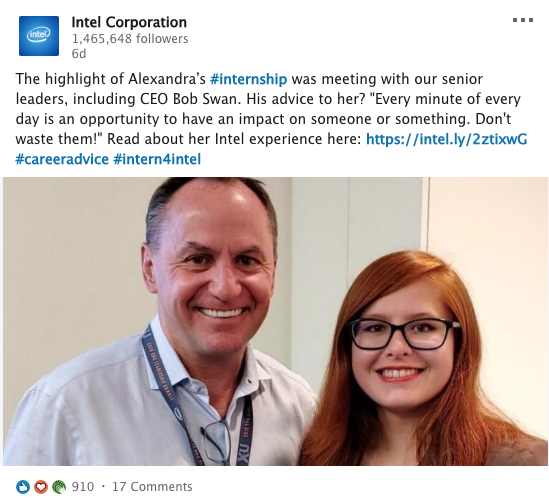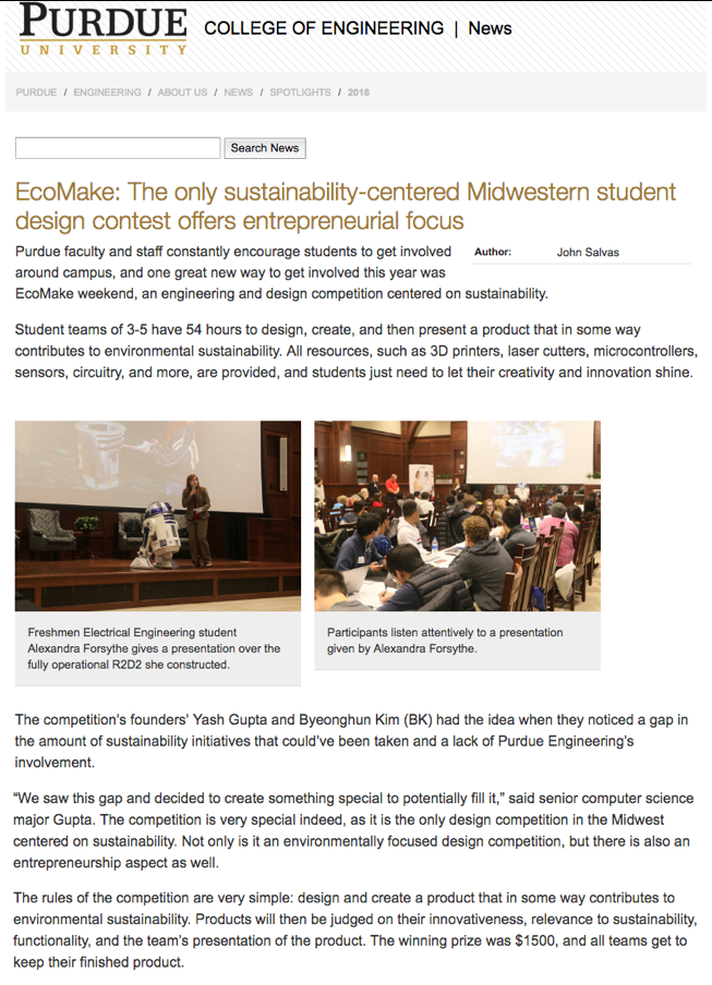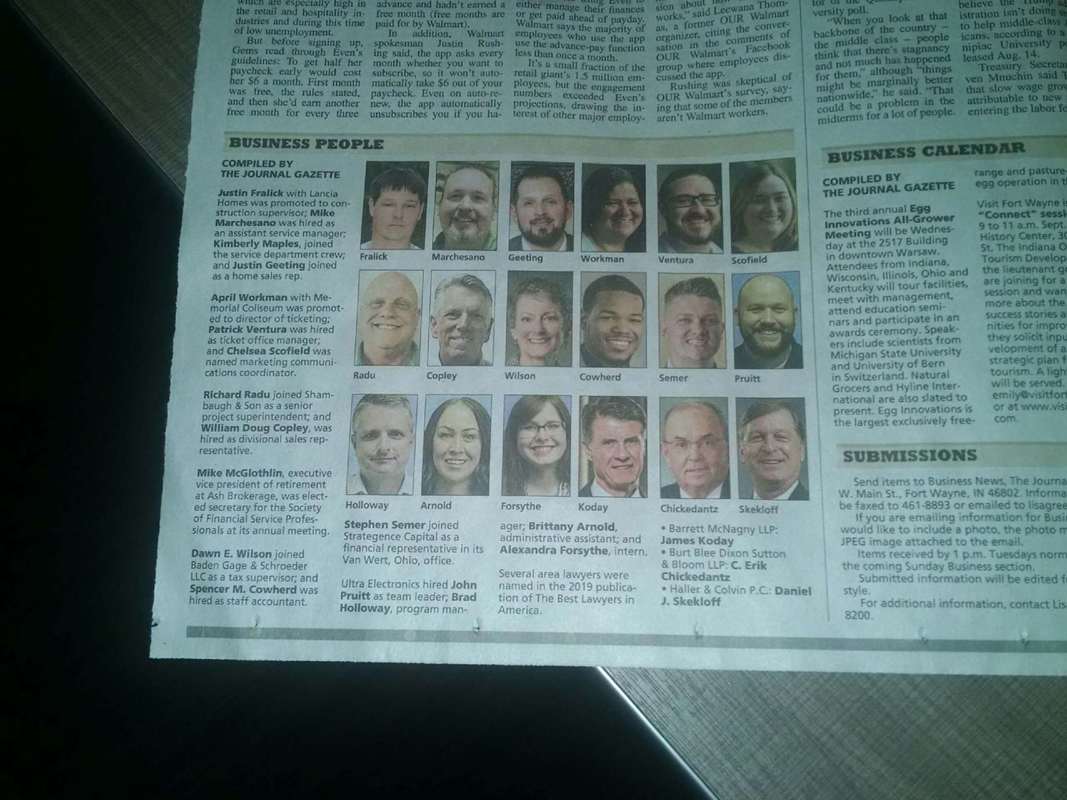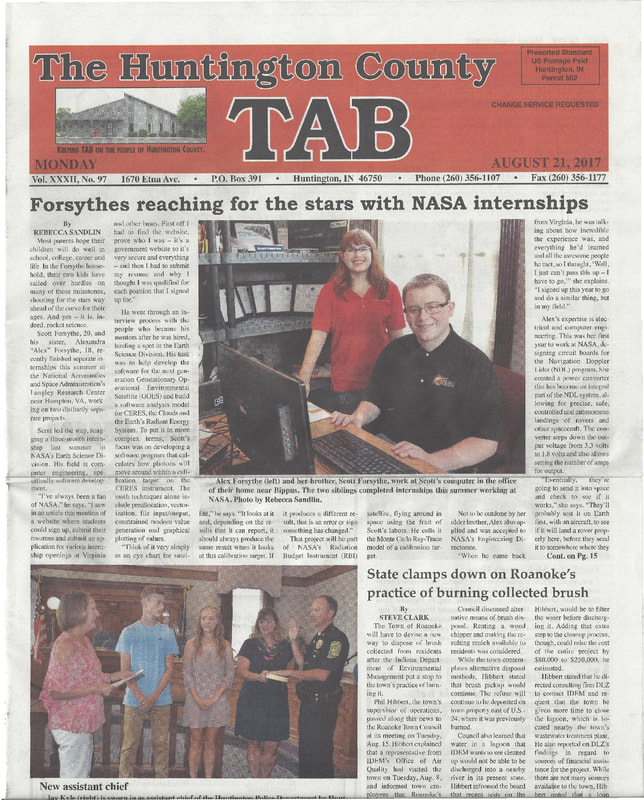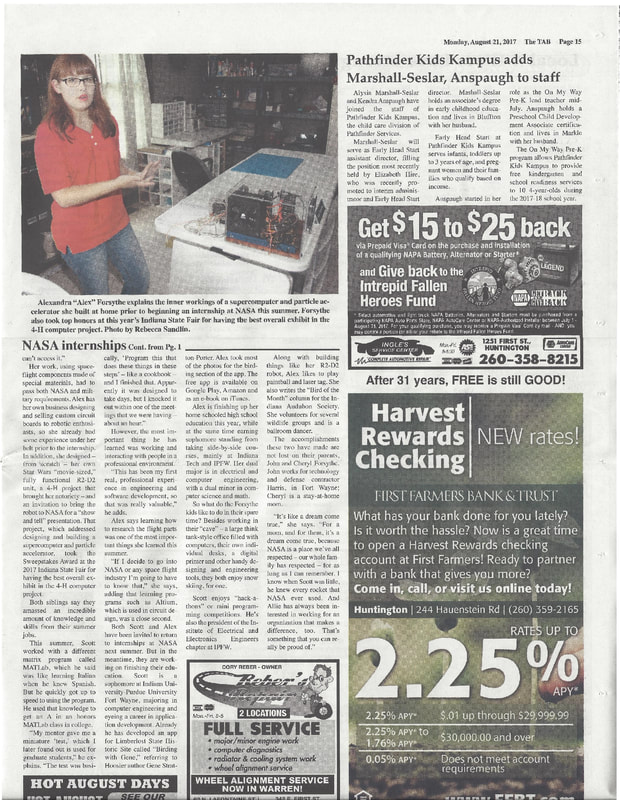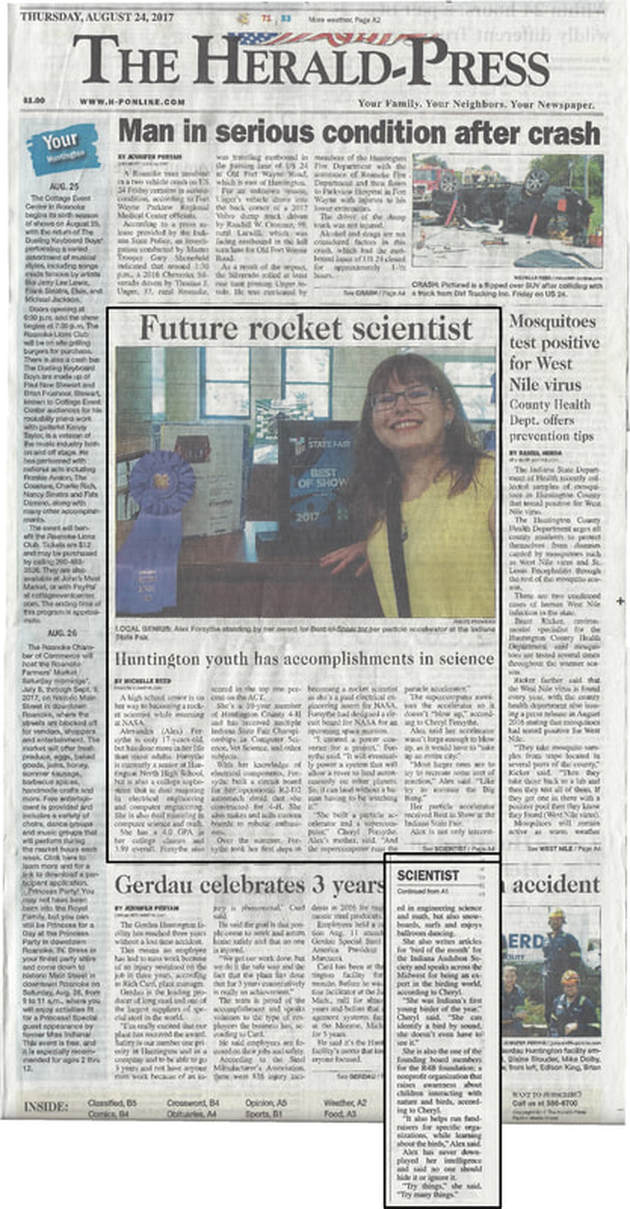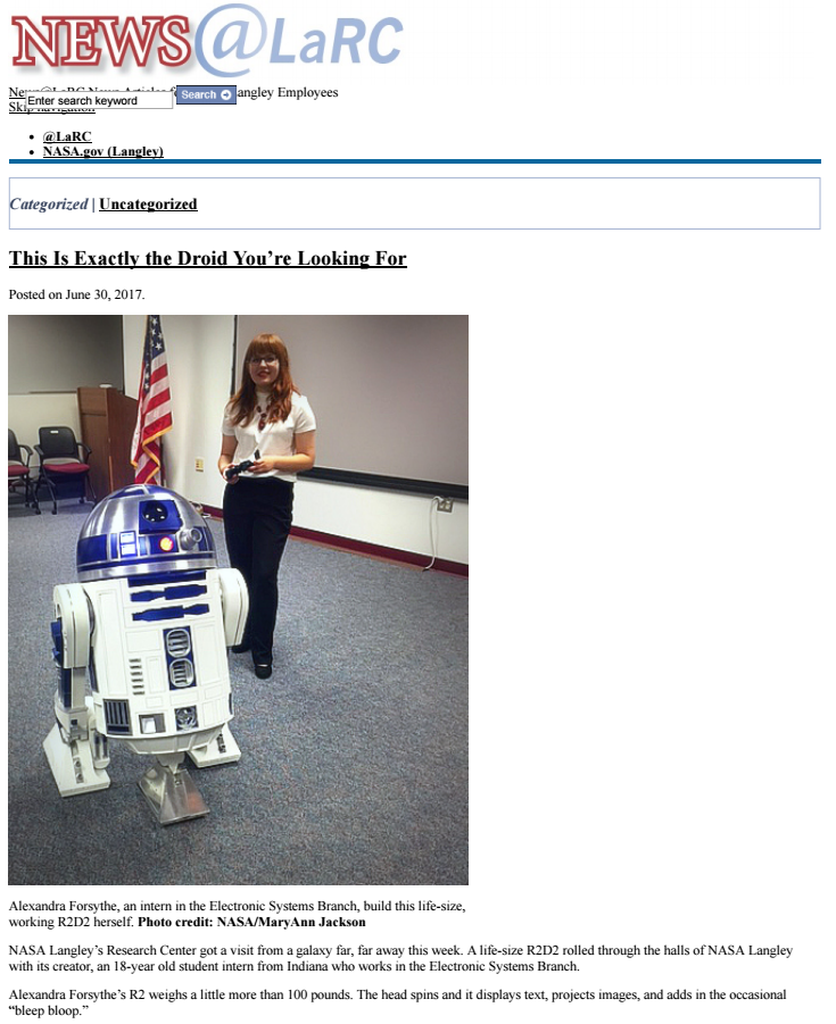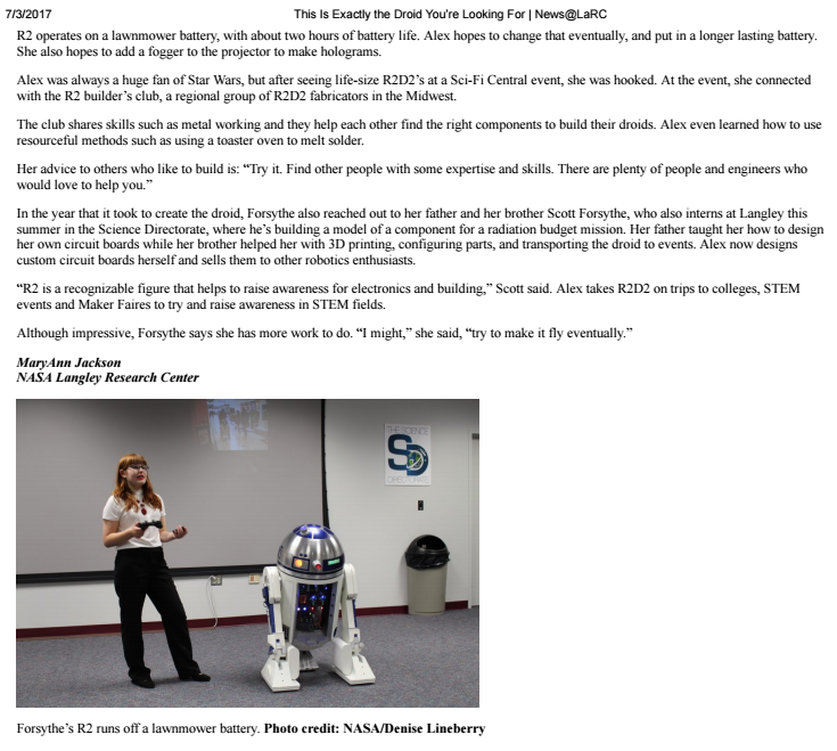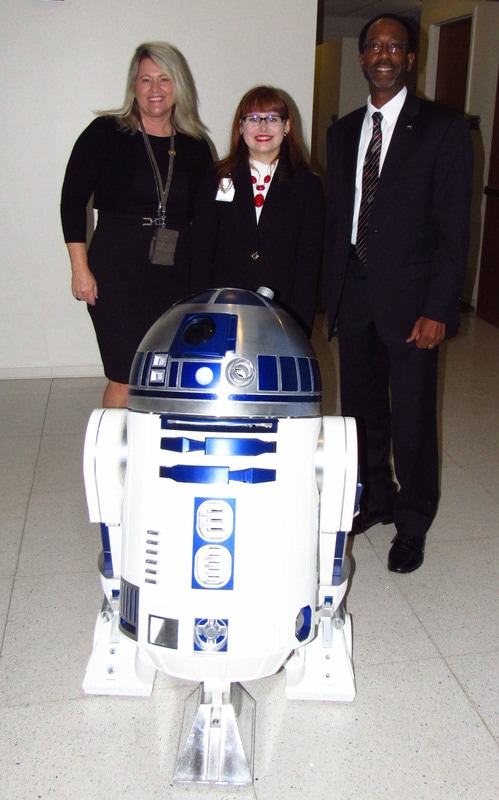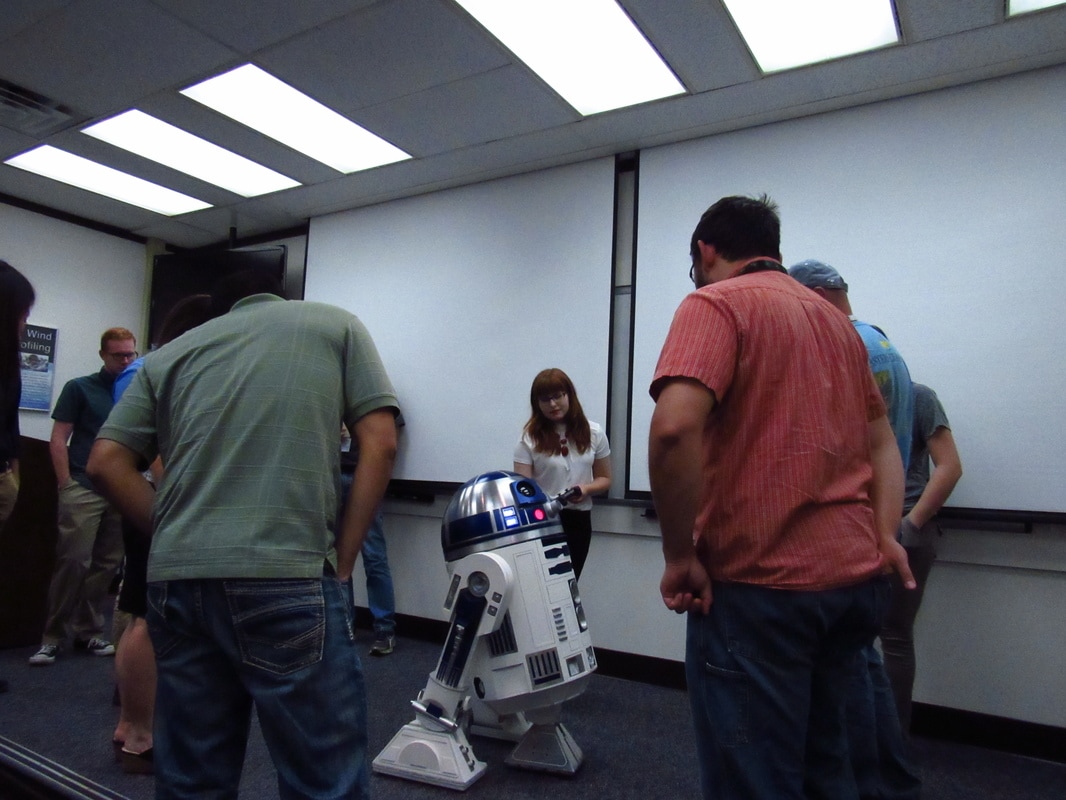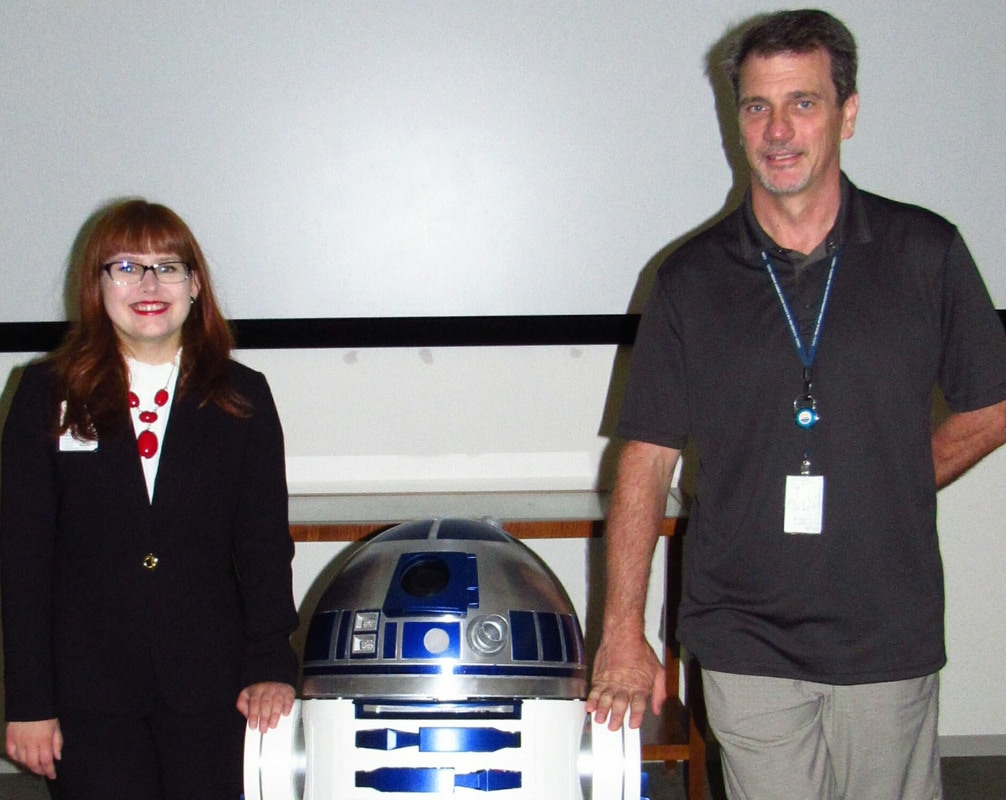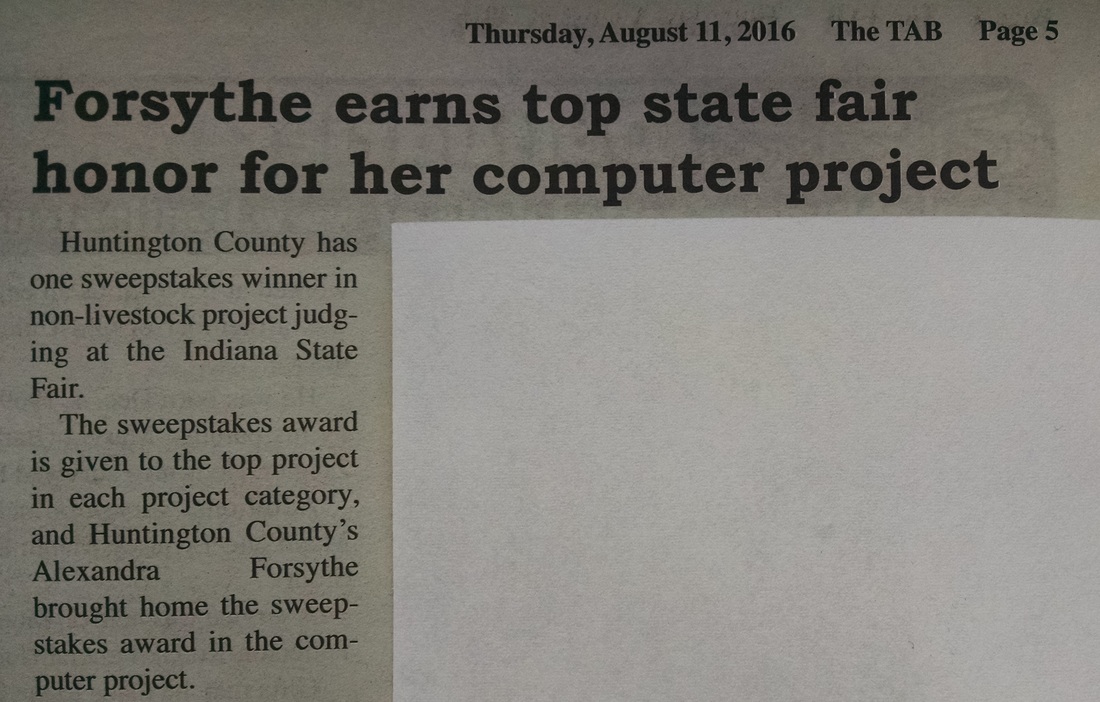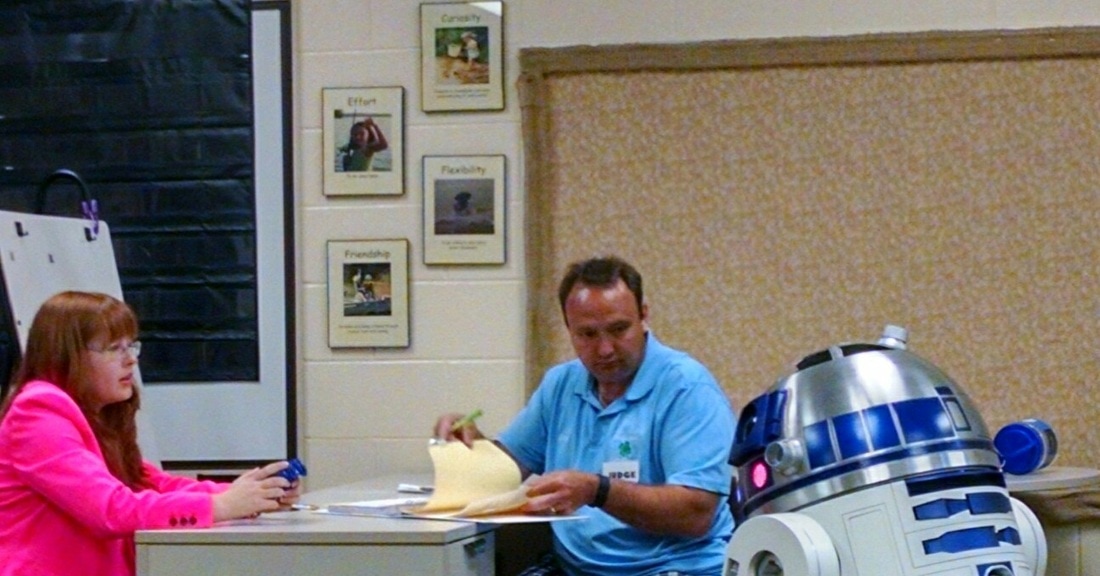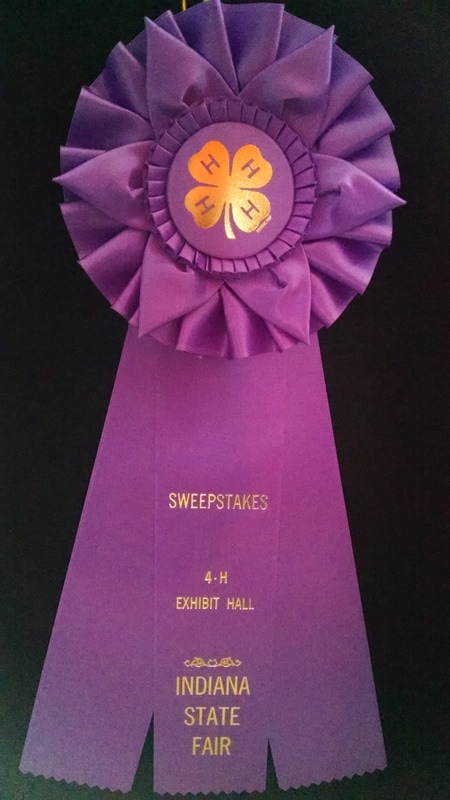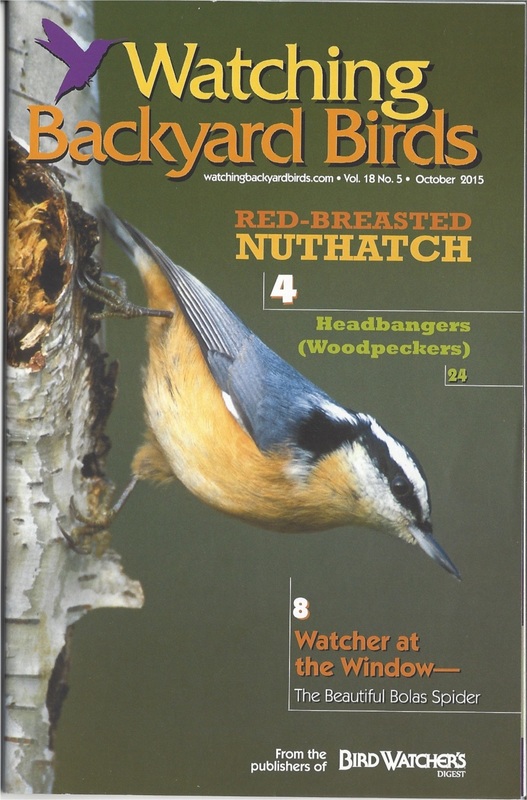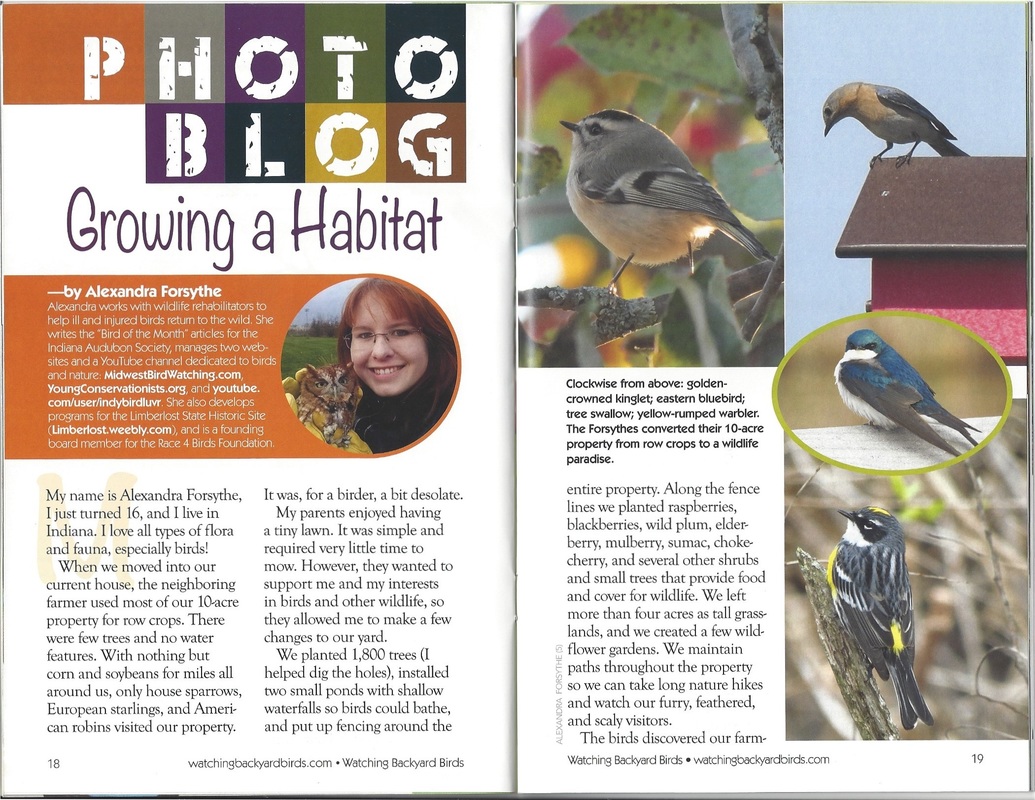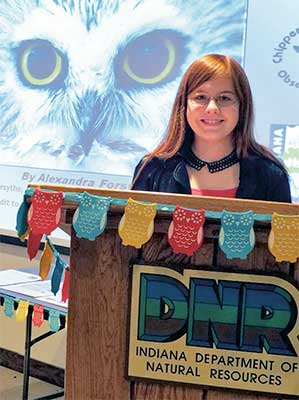I have been fortunate to be mentioned in news articles and a nationwide television program. It is humbling that the reporters would take the time to speak to me, and I am grateful to have had the opportunities to raise awareness. Most recently, I was asked to be the Convocation Speaker for a university.
Convocation Speaker, Indiana Tech (total enrollment 10,000+)
I was honored to be the Convocation Speaker for Indiana Tech!
I have spoken in front of large crowds before (150+), but this was by far my largest audience, both in-person and online (Indiana Tech's total enrollment is 10,000+). Needless to say, this was certainly the most humbling experience I have ever had in my life.
I have spoken in front of large crowds before (150+), but this was by far my largest audience, both in-person and online (Indiana Tech's total enrollment is 10,000+). Needless to say, this was certainly the most humbling experience I have ever had in my life.
Career Services Brochure, Indiana Tech
Intel on LinkedIn
I am honored that Intel posted about me on LinkedIn to their 1.4 million followers!
Announcement that I was hired by Ultra Electronics USSI
I'd been working for Ultra since March 2018 as an electrical engineering contractor. After my summer internship with Raytheon ended, Ultra hired me as a year-round intern. The internship with Ultra made it into the Business Section of the Journal Gazette over Labor Day weekend!
Journal Gazette, Business Section, September 2, 2018
Huntington County Tab (http://www.huntingtoncountytab.com)
Local earns IT Presidential Scholarship
May 14, 2018 8:03 AM
Alexandra Forsythe, daughter of John and Cheryl Forsythe, of Huntington, has earned the Presidential Scholarship to attend Indiana Tech in Fort Wayne.
Forsythe, a senior at Eagle Academy, will pursue a Bachelor of Science in electrical engineering and computer engineering. She will also be obtaining minors in computer science and math. She, along with other elite scholarship recipients, received her award at a banquet in Fort Wayne on Friday, March 23.
The Presidential Scholarship is awarded to four incoming Indiana Tech freshman each year, and consists of a full-tuition scholarship for all four years of the student’s undergraduate degree, provided the student meets the school’s academic criteria.
Forsythe interned for NASA in 2017, where she designed a circuit board that will be used in an upcoming space mission. In 2018, she will intern at Raytheon and be a contractor for Ultra/USSI. She is involved in the Phi Theta Kappa collegiate honor society. Alexandra’s awards include the 2018 National Women in Computing Award, a National Merit Commended Scholar, five Indiana 4-H championships in computer science, veterinary science, health and weeds, three research grants (Wise, Mumford and Keller), the American Citizenship Award and Indiana Audubon’s First Young Birder of the Year.
Local earns IT Presidential Scholarship
May 14, 2018 8:03 AM
Alexandra Forsythe, daughter of John and Cheryl Forsythe, of Huntington, has earned the Presidential Scholarship to attend Indiana Tech in Fort Wayne.
Forsythe, a senior at Eagle Academy, will pursue a Bachelor of Science in electrical engineering and computer engineering. She will also be obtaining minors in computer science and math. She, along with other elite scholarship recipients, received her award at a banquet in Fort Wayne on Friday, March 23.
The Presidential Scholarship is awarded to four incoming Indiana Tech freshman each year, and consists of a full-tuition scholarship for all four years of the student’s undergraduate degree, provided the student meets the school’s academic criteria.
Forsythe interned for NASA in 2017, where she designed a circuit board that will be used in an upcoming space mission. In 2018, she will intern at Raytheon and be a contractor for Ultra/USSI. She is involved in the Phi Theta Kappa collegiate honor society. Alexandra’s awards include the 2018 National Women in Computing Award, a National Merit Commended Scholar, five Indiana 4-H championships in computer science, veterinary science, health and weeds, three research grants (Wise, Mumford and Keller), the American Citizenship Award and Indiana Audubon’s First Young Birder of the Year.
Huntington County Tab (http://www.huntingtoncountytab.com)
Local girl wins pair of computer honors
Monday, April 30, 2018 8:23 AM
Eagle Academy student Alexandra Forsythe has received the Indiana Affiliate NCWIT Award for Aspirations in Computing as well as the National NCWIT Award for Aspirations in Computing.
The award, sponsored by the National Center for Women & Information Technology (NCWIT), OneAmerica, Women & Hi Tech, Society for Information Management-Indianapolis Chapter and Indiana University recognizes high school women for their computing-related achievements and interests as part of an effort to encourage more young women to choose careers in technology.
“Encouraging young women’s interest in technology careers is critical: our workforce needs their creativity and their innovation,” said Lucy Sanders, CEO and Co-founder of NCWIT. “We congratulate our award recipients for their dedication and vision for a brighter future in technology.”
A total of 23 award recipients and 23 honorable mentions were selected from high schools across the state of Indiana for their outstanding aptitude and interest in information technology and computing. Honorees also displayed solid leadership ability and a good academic history, and have plans for post-secondary education. Each award recipient receives $250 and two engraved awards—one for the student and one for her school’s trophy case.
Forsythe’s love of computing was inspired by a professor she met at an engineering camp. A dual credit student, 4-H Best of Show, active member of ACM, IEEE, SWE, Arduino/Microcontrollers Users Group, and Midwest R2 Builders, the Head of IT for Doud Orchards and the Huntington County Science Ambassador (Purdue Extension Office), Forsythe still finds the time to volunteer her time as a webmaster for several non-profit organizations and run her own business designing custom circuit boards.
This past summer she interned at NASA, where she worked to develop a mission critical circuit board. In the future, she plans to dual major in computer engineering and electrical engineering with dual minors in computer science and math.
The National Center for Women & Information Technology (NCWIT) is a non-profit community of more than 850 universities, companies, non-profits and government organizations nationwide working to increase women’s participation in computing and technology. NCWIT equips change leaders with resources for taking action in recruiting, retaining and advancing women from K-12 and higher education through industry and entrepreneurial careers. Find out more at www.ncwit.org.
NASA Newsletter
4-H project snowballs into big things for local youth
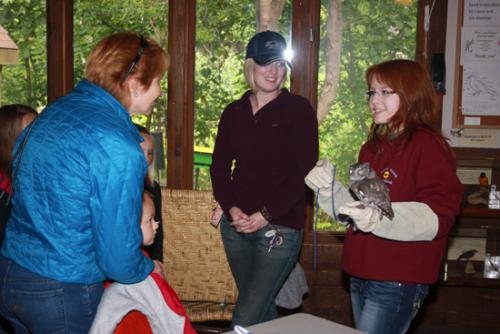
Joni Knott - Monday, October 6, 2014 Huntington County TAB
Alexandra Forsythe is a busy 15-year old dedicated to her community and the surrounding wildlife.
She's also the Indiana Audubon Society's first ever Young Birder of the Year and the recipient of the Charles D. Wise Youth Conservation Award.
As a youth advisor, presenter and speaker, webmaster and member, Forsythe volunteers her time to different avian societies and nature clubs and organizations.
The Indiana State Audubon Society, Stockbridge Audubon Society, Robert Cooper Audubon Society, Tippecanoe Audubon Society, Limberlost State Historic Site, Indiana Young Birders Club, Indiana Department of Natural Resources, ACRES Land Trust, Soarin' Hawk Raptor Rehab and the Race 4 Birds Foundation are but a few of the groups that she regularly assists in a variety of ways.
"It was a snowball effect," Forsythe says. "I learned about an organization where I heard about another organization, where I heard about yet another organization - and it just keeps going."
She's a member of the Crystal Clovers 4-H club in Huntington, and the "snowball" began with a 4-H wildlife project featuring different types of birdfeeders. As she learned more about birds and their differences, they became continually more intriguing to her.
"One of my favorites would be the saw-whet owl because it was my spark bird, but I don't have a specific favorite bird," says Forsythe. "The song sparrow has one of the prettiest songs, but they're just a little brown bird."
A spark bird is the title given to the first bird that captures the interest of a birder. The species of spark bird varies by birder; however, the result of the encounter is usually a heightened awareness and appreciation of birds in general.
Others in the birding community are eager to tutor interested youth and have helped to educate Forsythe on the finer points of different species of avian. They continually encourage her curiosity and involvement despite her young age.
"I read a lot of guide books and I try to spend as much time as I can with more experienced birders," Forsythe says. "The first experienced birder I knew was Brad Bumgardner, at the Indiana Dunes, and he along with Fred Wooley, at Pokagon, were the ones who got me interested in birds in the first place."
Having now been birding, researching and helping with rehabilitation for about four years, Forsythe is regularly asked to give presentations for a multitude of organizations and even has her own educational outreach program through Limberlost State Historic Site.
Participation in such a multitude of activities can be attributed not only to Forsythe's personal interest and dedication to nature and her organizations, but also to the support and help of her parents.
"We can't wait until she has her driver's license," says former lawyer and current stay-at-home mother/chauffer Cheryl Forsythe.
Alexandra Forsythe is also home schooled by her parents and given the flexibility to schedule her studies, volunteer work and other interests around each other.
"I can go do my presentations (for different organizations) during the technical school day and catch up (on homework) during the weekends or evenings," says Alexandra Forsythe. "I can also have spring migration off and fall migration off instead of just having summer off when there are really no birds around."
Her parents also allow her to rehabilitate birds at home and keep the yard in a manner that is pleasing to the surrounding wildlife.
"They support me with all of my stuff and encourage me in everything I do," Forsythe says.
Forsythe also has a host of non-wildlife hobbies including snowboarding, ballroom dancing, tap dancing, classical piano, paintball, skiing and snowboarding.
"I am also on the Teen Advisory Board for the American Library Association," says Forsythe.
Someday, she would like to have a career as a veterinarian specializing in small and exotic animals, particularly birds. She plans to continue to help with avian rehabilitation in the future.
For information about the surrounding birds and wildlife, visit Alexandra Forsythe's websites, www.midwestbirdwatching.com andwww.youngconservationists.org.
Alexandra Forsythe is a busy 15-year old dedicated to her community and the surrounding wildlife.
She's also the Indiana Audubon Society's first ever Young Birder of the Year and the recipient of the Charles D. Wise Youth Conservation Award.
As a youth advisor, presenter and speaker, webmaster and member, Forsythe volunteers her time to different avian societies and nature clubs and organizations.
The Indiana State Audubon Society, Stockbridge Audubon Society, Robert Cooper Audubon Society, Tippecanoe Audubon Society, Limberlost State Historic Site, Indiana Young Birders Club, Indiana Department of Natural Resources, ACRES Land Trust, Soarin' Hawk Raptor Rehab and the Race 4 Birds Foundation are but a few of the groups that she regularly assists in a variety of ways.
"It was a snowball effect," Forsythe says. "I learned about an organization where I heard about another organization, where I heard about yet another organization - and it just keeps going."
She's a member of the Crystal Clovers 4-H club in Huntington, and the "snowball" began with a 4-H wildlife project featuring different types of birdfeeders. As she learned more about birds and their differences, they became continually more intriguing to her.
"One of my favorites would be the saw-whet owl because it was my spark bird, but I don't have a specific favorite bird," says Forsythe. "The song sparrow has one of the prettiest songs, but they're just a little brown bird."
A spark bird is the title given to the first bird that captures the interest of a birder. The species of spark bird varies by birder; however, the result of the encounter is usually a heightened awareness and appreciation of birds in general.
Others in the birding community are eager to tutor interested youth and have helped to educate Forsythe on the finer points of different species of avian. They continually encourage her curiosity and involvement despite her young age.
"I read a lot of guide books and I try to spend as much time as I can with more experienced birders," Forsythe says. "The first experienced birder I knew was Brad Bumgardner, at the Indiana Dunes, and he along with Fred Wooley, at Pokagon, were the ones who got me interested in birds in the first place."
Having now been birding, researching and helping with rehabilitation for about four years, Forsythe is regularly asked to give presentations for a multitude of organizations and even has her own educational outreach program through Limberlost State Historic Site.
Participation in such a multitude of activities can be attributed not only to Forsythe's personal interest and dedication to nature and her organizations, but also to the support and help of her parents.
"We can't wait until she has her driver's license," says former lawyer and current stay-at-home mother/chauffer Cheryl Forsythe.
Alexandra Forsythe is also home schooled by her parents and given the flexibility to schedule her studies, volunteer work and other interests around each other.
"I can go do my presentations (for different organizations) during the technical school day and catch up (on homework) during the weekends or evenings," says Alexandra Forsythe. "I can also have spring migration off and fall migration off instead of just having summer off when there are really no birds around."
Her parents also allow her to rehabilitate birds at home and keep the yard in a manner that is pleasing to the surrounding wildlife.
"They support me with all of my stuff and encourage me in everything I do," Forsythe says.
Forsythe also has a host of non-wildlife hobbies including snowboarding, ballroom dancing, tap dancing, classical piano, paintball, skiing and snowboarding.
"I am also on the Teen Advisory Board for the American Library Association," says Forsythe.
Someday, she would like to have a career as a veterinarian specializing in small and exotic animals, particularly birds. She plans to continue to help with avian rehabilitation in the future.
For information about the surrounding birds and wildlife, visit Alexandra Forsythe's websites, www.midwestbirdwatching.com andwww.youngconservationists.org.
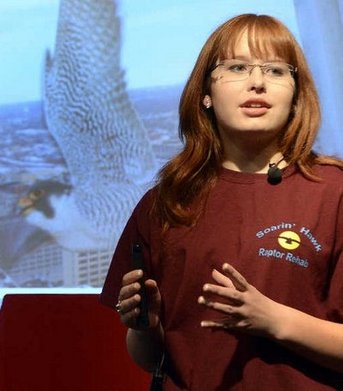
A bird’s-eye view of world: Huntington teen fascinated with feathered friends
by Jeff Wiehe, Fort Wayne Journal-Gazette, Thu. Jun. 19, 2014
At a glance:
Name: Alexandra Forsythe
Age: 15
Title: Indiana Young Birders Club Birder of the Year 2013
Hometown: Huntington
Hobbies/extracurricular: Birding, dancing, operating websites
Samuel Hoffman | The Journal Gazette
Alexandra Forsythe, 15, of Huntington gives a presentation on peregrine falcons. Her interest in owls blossomed into a passion for all things about birds.
What they do at the Indiana Dunes State Park sometimes is this:
They set up a net in the dark of night, and from the center of this net they play a recording of the mating calls for saw-whet owls. This is to lure owls into the net – not to be captured, but so that park officials can band them and keep track of the birds.
One night in 2011, a young saw-whet owl later dubbed “Nightshade” ended up in this net and fought so ferociously and became so entangled the net had to be cut. And that’s when the bird came face-to-face with Alexandra Forsythe. To Forsythe, Nightshade was what they call a “spark bird.”
“It really is adorable,” says Forsythe, who keeps a picture of Nightshade on the desktop of her computer.
Three years later, Forsythe is 15 years old. She’s also a walking encyclopedia of everything bird.
Did you know that owls cannot turn their head all the way around like some people think?
Forsythe knows that.
Did you know birds help humans by eating mice and insects, or even dead animals or seeds like ragweed, or that they pollinate crops?
Forsythe will be the first to tell you.
Did you know the great horned owl is the only animal to eat skunks because those birds have no sense of smell?
Well, they do.
That’s because the moment with Nightshade is what caused Forsythe to go full force into birding – which is the spotting and identifying of birds in their wild habitat.
She’s so into birding, and so driven and passionate, that she’s been named the Indiana Young Birders Club Birder of the Year for 2013 and also received the Charles D. Wise Youth Conservation Award from the Indiana Audubon Society.
The teen gives presentations about birds to all ages of people and can name nearly any fact or dispel any myth about the creatures.
“We don’t know where this came from,” says Forsythe’s mother, Cheryl Forsythe, who described her and her husband as now chauffeurs for their daughter’s activities. She said she and her husband never pushed their daughter into getting involved in activities, but somehow she found a passion for birds. And it’s led to them turning their Huntington home’s backyard into a habitat for many birds, with trails and trees spread throughout what used to be lawn. “We’re in awe of her,” Cheryl said. “She lets you see the world in a whole new light.”
Forsythe volunteers for several organizations, including the Soarin’ Hawk Raptor Rehab and has created and run several websites dedicated to her feathered friends.
While she still loves owls, she also has a penchant for colorful warblers, hawks and sparrows. But basically, she finds something special “about every bird,” she says.
Outside of birding, the teen has taken up dancing, even participating in several events that allowed her to show off her new ballroom dancing skills.
And despite her young age, she knows she wants to end up in veterinary school and ultimately wants to help the birds that got her first interested in the animals: owls.
And it’s all thanks to one little owl on a random night in 2011, an owl dubbed Nightshade by a bright and up and coming birder.
Who never looked at the birds the same again.
by Jeff Wiehe, Fort Wayne Journal-Gazette, Thu. Jun. 19, 2014
At a glance:
Name: Alexandra Forsythe
Age: 15
Title: Indiana Young Birders Club Birder of the Year 2013
Hometown: Huntington
Hobbies/extracurricular: Birding, dancing, operating websites
Samuel Hoffman | The Journal Gazette
Alexandra Forsythe, 15, of Huntington gives a presentation on peregrine falcons. Her interest in owls blossomed into a passion for all things about birds.
What they do at the Indiana Dunes State Park sometimes is this:
They set up a net in the dark of night, and from the center of this net they play a recording of the mating calls for saw-whet owls. This is to lure owls into the net – not to be captured, but so that park officials can band them and keep track of the birds.
One night in 2011, a young saw-whet owl later dubbed “Nightshade” ended up in this net and fought so ferociously and became so entangled the net had to be cut. And that’s when the bird came face-to-face with Alexandra Forsythe. To Forsythe, Nightshade was what they call a “spark bird.”
“It really is adorable,” says Forsythe, who keeps a picture of Nightshade on the desktop of her computer.
Three years later, Forsythe is 15 years old. She’s also a walking encyclopedia of everything bird.
Did you know that owls cannot turn their head all the way around like some people think?
Forsythe knows that.
Did you know birds help humans by eating mice and insects, or even dead animals or seeds like ragweed, or that they pollinate crops?
Forsythe will be the first to tell you.
Did you know the great horned owl is the only animal to eat skunks because those birds have no sense of smell?
Well, they do.
That’s because the moment with Nightshade is what caused Forsythe to go full force into birding – which is the spotting and identifying of birds in their wild habitat.
She’s so into birding, and so driven and passionate, that she’s been named the Indiana Young Birders Club Birder of the Year for 2013 and also received the Charles D. Wise Youth Conservation Award from the Indiana Audubon Society.
The teen gives presentations about birds to all ages of people and can name nearly any fact or dispel any myth about the creatures.
“We don’t know where this came from,” says Forsythe’s mother, Cheryl Forsythe, who described her and her husband as now chauffeurs for their daughter’s activities. She said she and her husband never pushed their daughter into getting involved in activities, but somehow she found a passion for birds. And it’s led to them turning their Huntington home’s backyard into a habitat for many birds, with trails and trees spread throughout what used to be lawn. “We’re in awe of her,” Cheryl said. “She lets you see the world in a whole new light.”
Forsythe volunteers for several organizations, including the Soarin’ Hawk Raptor Rehab and has created and run several websites dedicated to her feathered friends.
While she still loves owls, she also has a penchant for colorful warblers, hawks and sparrows. But basically, she finds something special “about every bird,” she says.
Outside of birding, the teen has taken up dancing, even participating in several events that allowed her to show off her new ballroom dancing skills.
And despite her young age, she knows she wants to end up in veterinary school and ultimately wants to help the birds that got her first interested in the animals: owls.
And it’s all thanks to one little owl on a random night in 2011, an owl dubbed Nightshade by a bright and up and coming birder.
Who never looked at the birds the same again.
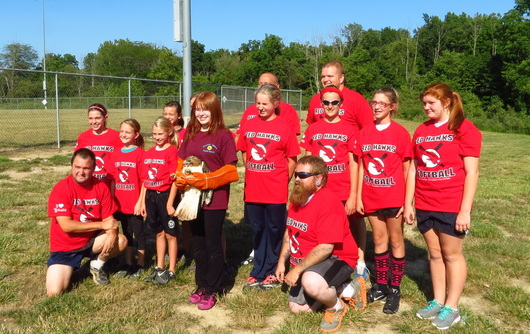
Experience of rescuing hawk inspires softball team
By Blake Sebring of The News-Sentinel
Friday, September 26, 2014 - 12:01 am
When the young softball players showed up for their first practice on July 13, what the girls discovered would change everything for them.
Because the coaches had told the 12 and younger team members they could pick the new team name, they were excitedly talking about Purple Unicorns, but they refocused after the 5 p.m. practice started at Huntington's Homier Park. Part of the squad split off for the nearby batting cage but soon some players ran back and yelled about a bird stuck in the cage.
"At first, I thought they just meant there was a nest there or a bird flying around inside the cage," co-coach Mike Rice said.
Instead, because it had become tangled in the batting cage net, an exhausted red-tailed hawk was hanging upside down, no longer trying to escape. Fearing possibly making the situation worse, the players were afraid to touch the bird, but coach Jay Stouder carefully cut the netting around the bird to set it on the ground.
The bird needed emergency help, but it took a while for a coach to find the number for Fort Wayne's Soarin' Hawk Raptor Rebab (241-0134). Then volunteer Alex Forsythe was called at her home just north of Bippus and rushed 20 minutes to the park.
Though she's 15, Forsythe is exceptionally gifted dealing with birds. Four years ago she found her calling when she witnessed the test flight for a rehabilitated eagle at Pokagon State Park, and she's worked the last three years with Soarin' Hawk. After starting rescues three months ago, she's already helped more than 10 birds.
Arriving at the park, Forsythe pulled on her welder's gloves and worked about a half hour to carefully and patiently ease the hawk out of the remaining strangling net.
Because the bird's tail feathers had already turned red, Forsythe knew the male was more than two years old. She also knew it was too injured to release, placed it in a special carrier, and, with her mother Cheryl driving, transported it to Soarin' Hawk veterinarian Pat Funnell.
"There wasn't any permanent damage, but the legs were swollen," Funnell said. "They were very painful because they were caught like that. Being out there like that, he may not have made it on his own."
According to Funnell, Soarin' Hawk rescued more than 125 birds last year with most needing three weeks rehabilitation. The organization is currently caring for more than 50 birds.
"Every bird we bring in has a story, but this one was so dramatic," Funnell said.
During the rehabilitation, the softball team continued to pray and hope for the hawk's recovery, getting regular updates from Stouder who kept in touch with Forsythe.
Four weeks later when the bird was fully recovered, Forsythe alerted Stouder of the release time. They returned on Aug. 15 to find about 30 players and their parents waiting, and the players were wearing red T-shirts displaying the new team name "Red Hawks" after a coach's suggestion and a unanimous vote.
That could have been the end of the story, and a totally moving moment, but the emotions were just getting started.
With Forsythe holding the bird in her padded gloves, everyone posed for pictures. Finally, Forsythe walked to the side of the diamond where there was a clear path for the bird to fly to the woods past center field. With everyone cheering, the bird flew about 100 yards to land 50 feet up in a dead tree's branches but still within sight.
Everyone watched for a few minutes before someone heard birds conversing, and then another larger, juvenile red-tail hawk flew over.
"One of the goals in getting them back out where they came from quickly is in the spring sometimes they have young they are taking care of, or maybe they have a mate there," Funnell said. "They already know where to hunt there, and babies stay with their parents until late in the fall."
The assumption is everyone got to see a reunion between father and daughter who had been waiting for the bird's return.
Everyone watching went from cheering to silent.
"One of the coaches said, `I've got goosebumps," Cheryl Forsythe said. "I think we all did. because it was just the most moving release I've ever attended. It was a really cool thing to be part of. I think it will stick with me forever."
Though the team is now playing in the Wallen Fall League, the coaches were part of a league meeting last week at Formier Park. Someone came in and said he thinks there's now a family of red-tail hawks living in the trees.
"It's kind of incredible really, and it made me almost want to cry," Alex Forsythe said. "I was so happy that we were able to get it back to the wild and find its family."
By Blake Sebring of The News-Sentinel
Friday, September 26, 2014 - 12:01 am
When the young softball players showed up for their first practice on July 13, what the girls discovered would change everything for them.
Because the coaches had told the 12 and younger team members they could pick the new team name, they were excitedly talking about Purple Unicorns, but they refocused after the 5 p.m. practice started at Huntington's Homier Park. Part of the squad split off for the nearby batting cage but soon some players ran back and yelled about a bird stuck in the cage.
"At first, I thought they just meant there was a nest there or a bird flying around inside the cage," co-coach Mike Rice said.
Instead, because it had become tangled in the batting cage net, an exhausted red-tailed hawk was hanging upside down, no longer trying to escape. Fearing possibly making the situation worse, the players were afraid to touch the bird, but coach Jay Stouder carefully cut the netting around the bird to set it on the ground.
The bird needed emergency help, but it took a while for a coach to find the number for Fort Wayne's Soarin' Hawk Raptor Rebab (241-0134). Then volunteer Alex Forsythe was called at her home just north of Bippus and rushed 20 minutes to the park.
Though she's 15, Forsythe is exceptionally gifted dealing with birds. Four years ago she found her calling when she witnessed the test flight for a rehabilitated eagle at Pokagon State Park, and she's worked the last three years with Soarin' Hawk. After starting rescues three months ago, she's already helped more than 10 birds.
Arriving at the park, Forsythe pulled on her welder's gloves and worked about a half hour to carefully and patiently ease the hawk out of the remaining strangling net.
Because the bird's tail feathers had already turned red, Forsythe knew the male was more than two years old. She also knew it was too injured to release, placed it in a special carrier, and, with her mother Cheryl driving, transported it to Soarin' Hawk veterinarian Pat Funnell.
"There wasn't any permanent damage, but the legs were swollen," Funnell said. "They were very painful because they were caught like that. Being out there like that, he may not have made it on his own."
According to Funnell, Soarin' Hawk rescued more than 125 birds last year with most needing three weeks rehabilitation. The organization is currently caring for more than 50 birds.
"Every bird we bring in has a story, but this one was so dramatic," Funnell said.
During the rehabilitation, the softball team continued to pray and hope for the hawk's recovery, getting regular updates from Stouder who kept in touch with Forsythe.
Four weeks later when the bird was fully recovered, Forsythe alerted Stouder of the release time. They returned on Aug. 15 to find about 30 players and their parents waiting, and the players were wearing red T-shirts displaying the new team name "Red Hawks" after a coach's suggestion and a unanimous vote.
That could have been the end of the story, and a totally moving moment, but the emotions were just getting started.
With Forsythe holding the bird in her padded gloves, everyone posed for pictures. Finally, Forsythe walked to the side of the diamond where there was a clear path for the bird to fly to the woods past center field. With everyone cheering, the bird flew about 100 yards to land 50 feet up in a dead tree's branches but still within sight.
Everyone watched for a few minutes before someone heard birds conversing, and then another larger, juvenile red-tail hawk flew over.
"One of the goals in getting them back out where they came from quickly is in the spring sometimes they have young they are taking care of, or maybe they have a mate there," Funnell said. "They already know where to hunt there, and babies stay with their parents until late in the fall."
The assumption is everyone got to see a reunion between father and daughter who had been waiting for the bird's return.
Everyone watching went from cheering to silent.
"One of the coaches said, `I've got goosebumps," Cheryl Forsythe said. "I think we all did. because it was just the most moving release I've ever attended. It was a really cool thing to be part of. I think it will stick with me forever."
Though the team is now playing in the Wallen Fall League, the coaches were part of a league meeting last week at Formier Park. Someone came in and said he thinks there's now a family of red-tail hawks living in the trees.
"It's kind of incredible really, and it made me almost want to cry," Alex Forsythe said. "I was so happy that we were able to get it back to the wild and find its family."
Raptor lesson to celebrate Fort Wayne as a Bird Town Indiana
By Ellie Bogue of The News-Sentinel
Thursday, September 11, 2014 - 7:37 am
First- and second-graders at Franke Park Elementary School got a lesson in raptor behavior Wednesday morning.
Members of Soarin' Hawk, a nonprofit that rehabilitates and then releases the raptors back into the wild, brought four birds to the school so students could get a first-hand look at them.
There were gasps of awe as Ruby the red-tailed hawk flapped her wings. Bob Walton, a volunteer for Soarin' Hawk, got a round of applause after demonstrating what barred owls sound like when they have a conversation with each other. Alex Forsythe, 15, a volunteer for Soarin' Hawk, fielded student questions including, Why do the birds flip their tails forward and backward while they are perched on their handler's arm? The answer: balance.
The presentation was all a part of a program from the Fort Wayne Parks & Recreation Department to celebrate Fort Wayne's recent “Bird Town Indiana” designation from the Indiana Audubon Society.
The event also included a talk from Liz Hincks, education coordinator, of the Little River Wetlands Project, and a presentation of a Bird Town sign from Jeff Canada, vice president of the Indiana Audubon Society to Al Moll, Parks and Recreation director.
Fort Wayne is only the fifth town in the state to receive this distinction from the Indiana Audubon Society. The designation is given to those communities that “demonstrate an active and ongoing commitment to the protection and conservation of bird populations and habitat.”
By Ellie Bogue of The News-Sentinel
Thursday, September 11, 2014 - 7:37 am
First- and second-graders at Franke Park Elementary School got a lesson in raptor behavior Wednesday morning.
Members of Soarin' Hawk, a nonprofit that rehabilitates and then releases the raptors back into the wild, brought four birds to the school so students could get a first-hand look at them.
There were gasps of awe as Ruby the red-tailed hawk flapped her wings. Bob Walton, a volunteer for Soarin' Hawk, got a round of applause after demonstrating what barred owls sound like when they have a conversation with each other. Alex Forsythe, 15, a volunteer for Soarin' Hawk, fielded student questions including, Why do the birds flip their tails forward and backward while they are perched on their handler's arm? The answer: balance.
The presentation was all a part of a program from the Fort Wayne Parks & Recreation Department to celebrate Fort Wayne's recent “Bird Town Indiana” designation from the Indiana Audubon Society.
The event also included a talk from Liz Hincks, education coordinator, of the Little River Wetlands Project, and a presentation of a Bird Town sign from Jeff Canada, vice president of the Indiana Audubon Society to Al Moll, Parks and Recreation director.
Fort Wayne is only the fifth town in the state to receive this distinction from the Indiana Audubon Society. The designation is given to those communities that “demonstrate an active and ongoing commitment to the protection and conservation of bird populations and habitat.”
CBS Sunday Morning
(CBS News) It's that time of the year when the call of the wild rings out loud and clear, in backyards and fields across America. Serena Altschul has been listening, and she reports our Cover Story:
Every May there is excitement in the air at the Magee Marsh boardwalk near Toledo, Ohio. Migratory songbirds have arrived from their long trip from South and Central America, and they pause on the shore of Lake Erie to gather their strength before continuing across the big water.
For Kim Kaufman, one of the organizers of what's billed as "the Biggest Week in American Birding," it's a magical time.
"Essentially what we're doing is connecting world travelers, birds and people, in this amazing place in northwest Ohio," Kaufman told Altschul.
Each year crowds of birders flock to ooh and aah over the warblers and finches and other tiny beautiful songbirds.
"You never know what you're gonna find out there," said Kaufman. "It's like a treasure hunt in some ways."
And the treasure is becoming ever more rare.
Figures show the populations of many of our most common birds are in steep decline -- down dramatically in the past 4 decades.
But still, "birders" as they're called keep coming - about 47 million of them, according to the U.S. Fish and Wildlife Service.
Impressive numbers for sure, but a new birding craze? British photographer Richard Crossley has his doubts. He doesn't see birding as being very popular in the U.S. "No, not compared to Britain or Europe or even other countries in the world. But it should be. That's the thing, it should be ten times bigger than what it is.
"I often tell people the only difference between America and Britain is, over here, there's five times as many birds, they come twice as close, they're everywhere, and the weather's always sunny. Apart from that it's just the same!"
Over in Indiana, the songbirds' seasonal migration is celebrated, too -- only a smaller scale.
At the Indiana Audubon Society's Mary Gray Bird Sanctuary, there's a competition for young people to see how many types of birds they can find in a single day. For 13-year-old Alexandra Forsythe, it's also a chance to try to get some good pictures.
And how many different species did Forsythe find? "Exactly 60 of them!"
And she has the pictures to prove it. Along with the purple finch, her snaps include an indigo bunting, a Kentucky warbler, and a ruby-throated hummingbird.
But as beautiful as they are, when she's out in the woods, it's the sounds that charm her.
"Even though you can't see them, you can just hear how beautiful they are," she told Altschul. "Sometimes even the dullest birds have the prettiest voices."
There's possibility behind each leaf.
Bird enthusiasts Major Randel Rogers and his fiancee, Doreen Whitley, discovered their first oven bird. The two met while birdwatching, and found they shared this mutual passion. They will soon be married.
"We flock together!" laughed Rogers.
Rogers brought his birdwatching zeal with him when he was posted to Iraq. "The diversity of wildlife in Iraq and the birdlife is amazing," he said. "I found eventually 127 species of birds just on Al Asad Airbase, where I was stationed."
In another part of Indiana, author Brian Kimberling found inspiration for his first novel, "Snapper," deep in the Yellowwood State Forest. While in college Kimberling was paid to count birds here. So how does a professional birdwatcher do it?
"I would find a log like this, and I would have a granola bar and a Sweetwater and read Mark Twain for a half-hour, and then after a half-hour, nobody would remember that I was there and I'd look around and see what was going on," he said.
For wildlife ecology professor Drew Lanham, birds are all about discovering the unknown and finding the opportunity to dream.
"It's totally magical," Lanham told Altschul. "I still have dreams of these birds going places that I would like to go, and I imagine the miracle that each one of those birds is and the places they've come from, and the things that they've flown over and through."
He dreams of seeing urban kids of all races getting excited about watching birds.
"You take anyone to a city park this time a year when birds are moving, and they can see incredible things. They can see incredible things from incredible places," he said. "Just takes a little looking, and a little patience."
But if you want to get back to a more primeval place, a canoe trip down Ohio's Green Creek as part of the biggest birding week is a journey back in time.
Tom Kashmer first paddled here more than 60 years ago. "This is like a birder's paradise in the spring," he said.
"Wow, it's beautiful in here," Altschul said.
"We usually see a lot of snakes on this creek!" he laughed.
Yes, snakes, raccoons, and bald eagles can still be found here. For organizer Kim Kaufman, it's all part of a plan.
"What we really want to focus on is people becoming birders, but then taking that step to becoming bird conservationists and supporting habitat conservation in the area," Kaufman told Altschul. "And at least in this small corner of Ohio, there is indeed a bird habitat worth marveling over."
WEB EXCLUSIVE VIDEO: At the Mary Gray Bird Sanctuary Altschul held an exhausted hummingbird in her hand until it came to life, as recorded by Alexandra Forsythe.
Every May there is excitement in the air at the Magee Marsh boardwalk near Toledo, Ohio. Migratory songbirds have arrived from their long trip from South and Central America, and they pause on the shore of Lake Erie to gather their strength before continuing across the big water.
For Kim Kaufman, one of the organizers of what's billed as "the Biggest Week in American Birding," it's a magical time.
"Essentially what we're doing is connecting world travelers, birds and people, in this amazing place in northwest Ohio," Kaufman told Altschul.
Each year crowds of birders flock to ooh and aah over the warblers and finches and other tiny beautiful songbirds.
"You never know what you're gonna find out there," said Kaufman. "It's like a treasure hunt in some ways."
And the treasure is becoming ever more rare.
Figures show the populations of many of our most common birds are in steep decline -- down dramatically in the past 4 decades.
But still, "birders" as they're called keep coming - about 47 million of them, according to the U.S. Fish and Wildlife Service.
Impressive numbers for sure, but a new birding craze? British photographer Richard Crossley has his doubts. He doesn't see birding as being very popular in the U.S. "No, not compared to Britain or Europe or even other countries in the world. But it should be. That's the thing, it should be ten times bigger than what it is.
"I often tell people the only difference between America and Britain is, over here, there's five times as many birds, they come twice as close, they're everywhere, and the weather's always sunny. Apart from that it's just the same!"
Over in Indiana, the songbirds' seasonal migration is celebrated, too -- only a smaller scale.
At the Indiana Audubon Society's Mary Gray Bird Sanctuary, there's a competition for young people to see how many types of birds they can find in a single day. For 13-year-old Alexandra Forsythe, it's also a chance to try to get some good pictures.
And how many different species did Forsythe find? "Exactly 60 of them!"
And she has the pictures to prove it. Along with the purple finch, her snaps include an indigo bunting, a Kentucky warbler, and a ruby-throated hummingbird.
But as beautiful as they are, when she's out in the woods, it's the sounds that charm her.
"Even though you can't see them, you can just hear how beautiful they are," she told Altschul. "Sometimes even the dullest birds have the prettiest voices."
There's possibility behind each leaf.
Bird enthusiasts Major Randel Rogers and his fiancee, Doreen Whitley, discovered their first oven bird. The two met while birdwatching, and found they shared this mutual passion. They will soon be married.
"We flock together!" laughed Rogers.
Rogers brought his birdwatching zeal with him when he was posted to Iraq. "The diversity of wildlife in Iraq and the birdlife is amazing," he said. "I found eventually 127 species of birds just on Al Asad Airbase, where I was stationed."
In another part of Indiana, author Brian Kimberling found inspiration for his first novel, "Snapper," deep in the Yellowwood State Forest. While in college Kimberling was paid to count birds here. So how does a professional birdwatcher do it?
"I would find a log like this, and I would have a granola bar and a Sweetwater and read Mark Twain for a half-hour, and then after a half-hour, nobody would remember that I was there and I'd look around and see what was going on," he said.
For wildlife ecology professor Drew Lanham, birds are all about discovering the unknown and finding the opportunity to dream.
"It's totally magical," Lanham told Altschul. "I still have dreams of these birds going places that I would like to go, and I imagine the miracle that each one of those birds is and the places they've come from, and the things that they've flown over and through."
He dreams of seeing urban kids of all races getting excited about watching birds.
"You take anyone to a city park this time a year when birds are moving, and they can see incredible things. They can see incredible things from incredible places," he said. "Just takes a little looking, and a little patience."
But if you want to get back to a more primeval place, a canoe trip down Ohio's Green Creek as part of the biggest birding week is a journey back in time.
Tom Kashmer first paddled here more than 60 years ago. "This is like a birder's paradise in the spring," he said.
"Wow, it's beautiful in here," Altschul said.
"We usually see a lot of snakes on this creek!" he laughed.
Yes, snakes, raccoons, and bald eagles can still be found here. For organizer Kim Kaufman, it's all part of a plan.
"What we really want to focus on is people becoming birders, but then taking that step to becoming bird conservationists and supporting habitat conservation in the area," Kaufman told Altschul. "And at least in this small corner of Ohio, there is indeed a bird habitat worth marveling over."
WEB EXCLUSIVE VIDEO: At the Mary Gray Bird Sanctuary Altschul held an exhausted hummingbird in her hand until it came to life, as recorded by Alexandra Forsythe.
Meet Forsythe — Young Birder of the Year Megan Greve/[email protected]
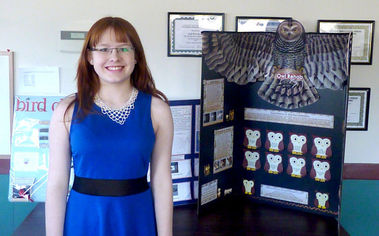
Alexandra "Alex" Forsythe of Bippus poses in front of some of the posters she uses for presentations Wednesday. Forsythe will be presenting at Soarin' Hawk Raptor Rehab's Second Annual Raptor Expo Saturday near the Fort Wayne Children's Zoo.
Posted: Thursday, April 24, 2014 8:00 pm
BY MEGAN GREVE
BIPPUS — What started as a 4-H project on birds has become a passion for 14-year-old Alexandra “Alex” Forsythe of Bippus.
“I had to do a poster on birds that came to my feeders,” Alexandra Forsythe explained, adding that poster made it to the Indiana State Fair. At the fair she encountered other enthusiasts who got her more involved in birding.
“About a year later I went on a Christmas bird count and there I met Holly Meyers and she was part of Soarin’ Hawk (Raptor Rehab). So she invited me to come watch one of the practice flights for one of their eagles who they later released,” Alexandra Forsythe said.
By then, she was hooked.
“I’ve been working at Soarin’ Hawk ever since and I’ve been doing presentations for them and for other groups all across the state,” Alexandra Forsythe said.
The 14-year-old homeschool student has given presentations at Indiana Dunes State Park, Salamonie State Park, Pokagon State Park, Limberlost State Historic Site, the Indiana Audubon Little River Wetlands Project and for the Junior and Master Naturalists.
She also has two websites, MidwestBirdWatching.com andYoungConservationists.org, where people can get information about birds and birding. She is also a member of the Indiana Young Birders Club.
Because of her efforts, Forsythe was awarded the first ever Indiana Young Birder of the Year from the Indiana Audubon Society in 2013. In addition, she was also awarded the Cooper Audubon Society's Charles D. Wise Youth Conservation Award on Nov. 11, 2013 “for her outstanding efforts with raising awareness of wild birds,” according to the Indiana Audubon Society’s website.
Alexandra Forsythe said she loves teaching others.
“It’s getting to teach people about the birds, so doing all these presentations and telling people how amazing these birds are, that’s what keeps me really interested in the birds. And just because birds are so incredible really,” she said.
Alexandra Forsythe said she hopes to teach people how useful raptors are — “Raptors eat a ton of mice. One Eastern screech owl (which can be between 6 and 9 inches tall) can eat five mice per night,” she said — and that people don’t need to worry that raptors will hurt them or their animals — “They don’t do that very often,” she said.
Alexandra Forsythe will get the opportunity to present several more times this year. On Saturday she will be representing Soarin’ Hawk Raptor Rehab at its Second Annual Raptor Expo at the Franke Park Pavilion No. 1 next to the Fort Wayne Children’s Zoo.
Alexandra Forsythe will be speaking at 4:30 p.m. about Indiana raptors as well as sharing facts and myths about them.
She will also be speaking June 17 at the Thorntown Public Library, June 19 at Fox Island County Park, June 21 at Wildwood Nature Preserve, July 15 at the New Castle-Henry County Public Library and July 24 at the Wells County Public Library, according to MidwestBirdWatching.com.
“Her father and I are amazed. Neither one of us knows anything about birds. She has grown tremendously through her interest in birds,” Alexandra Forsythe’s mother Cheryl Forsythe said. “She’s comfortable with public speaking, which is very unusual for a 14-year-old, and she’s become quite an ambassador.”
But Alexandra Forsythe’s love of birds doesn’t stop at presentations and she hopes to build on it in the future.
When she becomes 18 years old she hopes to be able to handle Soarin’ Hawk raptors alone during her presentations, she said.
“I do plan to become a vet so I’m hoping to become the vet for Soarin’ Hawk eventually and at least continue helping raptors so eventually I’ll learn how to rehab the raptors so I can help all of these cool birds,” Alexandra Forsythe said.
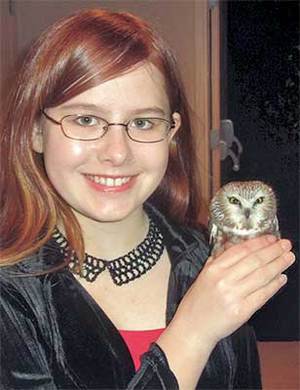 Alexandra holds a Saw-whet Owl, ready for release after being measured and leg banded.
Alexandra holds a Saw-whet Owl, ready for release after being measured and leg banded.
Young people soar with birding
By Dave Fox, Family Magazine, Wednesday, May 1, 2013
Have you ever wondered how to get your children interested in the great outdoors and all it has to offer? One thing I have learned about being an interpretive naturalist is to “know your audience.” Gene Stratton-Porter, Indiana’s most widely-read female author, saw the disconnect between children and nature more than 100 years ago. Her solution was to get them to experience nature through her books and movies. Today, kids are so technologically savvy that engaging them with something they love like a tablet or smart phone is an equally easy way to connect them to the natural world.
A nationwide movement to get youth more involved in birding is rapidly gaining strength and very successful programs have been developed to encourage today’s youth to explore the outdoors through birding. In Ohio, the Ohio Young Birder’s Club was founded in 2006 by Kimberly Kaufman, executive director of the Black Swamp Bird Observatory. She is the wife of Kenn Kaufman, a South Bend native, who is an internationally known birder and the author of the Kaufmann field guide series.
Both Kenn and Kimberly have seen the many benefits of involving youth in birding. Aside from founding the Ohio Young Birder’s Club in Ohio, they have been involved in birding camps for teenagers spanning the country from Arizona to Maine and have offered youth birding programs on a national level through the American Birding Association.
Kenn quipped that birding invariably leads to kids getting interested in more than birds on their adventures. “Rocks, beetles and even the occasional water snake or two” have become subjects of interest during the bird hikes he leads.
Indiana Young Birder’s Club sponsored by the Indiana Audubon Society began in 2009, and has broadened many young birders lives in areas far beyond learning about birds as well. Alexandra Forsythe is one of northeast Indiana’s youth birding success stories. Her parents, John and Cheryl, and naturalist, Fred Wooley at Pokagon State Park, encouraged her to explore birding at the age of 12. She volunteers at Pokagon in the nature center to learn new birds through observation and by talking to avid birders like Fred and others who come to visit. She has learned a great deal about birds and also about the natural world in general and the value of volunteerism. She is overcoming her shyness by giving presentations to other young birders about her experiences. Keeping her life list in Microsoft Excel has even helped her master computer skills!
Dave W. Fox is Natural History Section manager and Gene Stratton-Porter site manager, 1205 Pleasant Point, Rome City. Contact him at 854-3790 or [email protected]
By Dave Fox, Family Magazine, Wednesday, May 1, 2013
Have you ever wondered how to get your children interested in the great outdoors and all it has to offer? One thing I have learned about being an interpretive naturalist is to “know your audience.” Gene Stratton-Porter, Indiana’s most widely-read female author, saw the disconnect between children and nature more than 100 years ago. Her solution was to get them to experience nature through her books and movies. Today, kids are so technologically savvy that engaging them with something they love like a tablet or smart phone is an equally easy way to connect them to the natural world.
A nationwide movement to get youth more involved in birding is rapidly gaining strength and very successful programs have been developed to encourage today’s youth to explore the outdoors through birding. In Ohio, the Ohio Young Birder’s Club was founded in 2006 by Kimberly Kaufman, executive director of the Black Swamp Bird Observatory. She is the wife of Kenn Kaufman, a South Bend native, who is an internationally known birder and the author of the Kaufmann field guide series.
Both Kenn and Kimberly have seen the many benefits of involving youth in birding. Aside from founding the Ohio Young Birder’s Club in Ohio, they have been involved in birding camps for teenagers spanning the country from Arizona to Maine and have offered youth birding programs on a national level through the American Birding Association.
Kenn quipped that birding invariably leads to kids getting interested in more than birds on their adventures. “Rocks, beetles and even the occasional water snake or two” have become subjects of interest during the bird hikes he leads.
Indiana Young Birder’s Club sponsored by the Indiana Audubon Society began in 2009, and has broadened many young birders lives in areas far beyond learning about birds as well. Alexandra Forsythe is one of northeast Indiana’s youth birding success stories. Her parents, John and Cheryl, and naturalist, Fred Wooley at Pokagon State Park, encouraged her to explore birding at the age of 12. She volunteers at Pokagon in the nature center to learn new birds through observation and by talking to avid birders like Fred and others who come to visit. She has learned a great deal about birds and also about the natural world in general and the value of volunteerism. She is overcoming her shyness by giving presentations to other young birders about her experiences. Keeping her life list in Microsoft Excel has even helped her master computer skills!
Dave W. Fox is Natural History Section manager and Gene Stratton-Porter site manager, 1205 Pleasant Point, Rome City. Contact him at 854-3790 or [email protected]
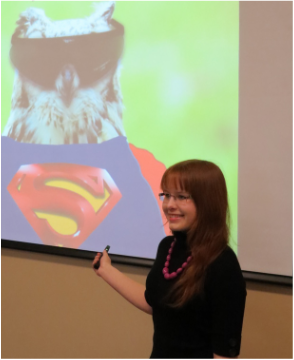
Great horned owl released at covered bridge Sunday
Authored by Jim Langham on Mar 31, 2014
The parking lot at the Ceylon Covered Bridge filled quickly late Sunday afternoon as a large crowd gathered for the release of a great horned owl that had originally been injured when it was struck by a vehicle in Fort Wayne.
Pam Whitacre, of Soarin’ Hawk Raptor Rehab in Fort Wayne said the owl had been rescued from an intersection after it had been struck by a car and had been nursed back to health over a six month period. She noted that it could have been released two months ago but was kept in shelter due to the heavy snow cover.
“It would have been difficult for the owl to find its animals of prey with so much snow on the ground,” said Whitacre.
Whitacre said that determination to release the owl had been made because it was eating well and doing well with experimental releasing. She noted that the owls are placed on a 100-foot line and then brought back.
“She seemed to have good flying ability when we retrieved her,” observed Whitacre. “This is a very difficult moment for me. You become quite attached to these animals and sometimes it is hard to let them go.”
When Whitacre released the owl, it flew into a large tree along the Wabash River and perched there to the applause of the crowd.
“I’ve never seen anything like this before,” said Carlie Sealscott, a fourth grader at South Adams. “Coming to see this is something I will always remember.”
“It was pretty awesome, I thought it was cool,” noted Brady Fox, grandchild of Dave and Judy Fox and child of Lydia and Kevin Fox.
Berne’s Camarra Yates brought her children to the event, but there was also a very special history behind her history in the event. Years ago she worked at an emergency veterinary hospital in Fort Wayne. In fact, she had actually assisted with the surgery of a great horned own.
“I was touched by the absolute freedom it experienced when it flew away,” noted Yates.
Many of those who attended the owl release had been to a special lecture on Indiana owls given by Alexandra Forsythe at the Limberlost visitor’s center.
One such individual was Cindy Rieth, daughter of Catherine Pyle Strickler, a pioneer of Geneva schools and a history enthusiast who had grown up in the area.
“I think this is all so awesome,” said Rieth. “Geneva meant so much to my mother. We used to come down to the Limberlost. She would have been happy to see her grandkids enjoy an afternoon such as this.”
Rieth laughed when she told the story of how her mother once fell into the Wabash River by the covered bridge.
“She had gone to church. On her way home, she tried to swing across the river on a vine. Instead, it broke and she fell into the river. She had to swim out with all of her good clothes on. Needless to say, grandma wasn’t too happy about that,” said Rieth.
Also present on Sunday was Nick Rieth from Decatur, who had brought his children, Reagan and Jackson to the event. Rieth said that before attending the afternoon’s events, he and the children had read books about owls so they would be more acquainted about what they were going to hear about and experience. “It was all enlightening. We learned a lot,” said Rieth. “We were excited to see the owl released.”
Robert Hill and his wife, Sondo, live in Muncie and are members of the Robert Cooper Audubon Society. It was an announcement in that organization’s newsletter that brought the Hills to the Limberlost.
“We really enjoyed Alexandra Forsythe. She did a really good job. We were really impressed with all that she knows about owls,” said Hill.
Authored by Jim Langham on Mar 31, 2014
The parking lot at the Ceylon Covered Bridge filled quickly late Sunday afternoon as a large crowd gathered for the release of a great horned owl that had originally been injured when it was struck by a vehicle in Fort Wayne.
Pam Whitacre, of Soarin’ Hawk Raptor Rehab in Fort Wayne said the owl had been rescued from an intersection after it had been struck by a car and had been nursed back to health over a six month period. She noted that it could have been released two months ago but was kept in shelter due to the heavy snow cover.
“It would have been difficult for the owl to find its animals of prey with so much snow on the ground,” said Whitacre.
Whitacre said that determination to release the owl had been made because it was eating well and doing well with experimental releasing. She noted that the owls are placed on a 100-foot line and then brought back.
“She seemed to have good flying ability when we retrieved her,” observed Whitacre. “This is a very difficult moment for me. You become quite attached to these animals and sometimes it is hard to let them go.”
When Whitacre released the owl, it flew into a large tree along the Wabash River and perched there to the applause of the crowd.
“I’ve never seen anything like this before,” said Carlie Sealscott, a fourth grader at South Adams. “Coming to see this is something I will always remember.”
“It was pretty awesome, I thought it was cool,” noted Brady Fox, grandchild of Dave and Judy Fox and child of Lydia and Kevin Fox.
Berne’s Camarra Yates brought her children to the event, but there was also a very special history behind her history in the event. Years ago she worked at an emergency veterinary hospital in Fort Wayne. In fact, she had actually assisted with the surgery of a great horned own.
“I was touched by the absolute freedom it experienced when it flew away,” noted Yates.
Many of those who attended the owl release had been to a special lecture on Indiana owls given by Alexandra Forsythe at the Limberlost visitor’s center.
One such individual was Cindy Rieth, daughter of Catherine Pyle Strickler, a pioneer of Geneva schools and a history enthusiast who had grown up in the area.
“I think this is all so awesome,” said Rieth. “Geneva meant so much to my mother. We used to come down to the Limberlost. She would have been happy to see her grandkids enjoy an afternoon such as this.”
Rieth laughed when she told the story of how her mother once fell into the Wabash River by the covered bridge.
“She had gone to church. On her way home, she tried to swing across the river on a vine. Instead, it broke and she fell into the river. She had to swim out with all of her good clothes on. Needless to say, grandma wasn’t too happy about that,” said Rieth.
Also present on Sunday was Nick Rieth from Decatur, who had brought his children, Reagan and Jackson to the event. Rieth said that before attending the afternoon’s events, he and the children had read books about owls so they would be more acquainted about what they were going to hear about and experience. “It was all enlightening. We learned a lot,” said Rieth. “We were excited to see the owl released.”
Robert Hill and his wife, Sondo, live in Muncie and are members of the Robert Cooper Audubon Society. It was an announcement in that organization’s newsletter that brought the Hills to the Limberlost.
“We really enjoyed Alexandra Forsythe. She did a really good job. We were really impressed with all that she knows about owls,” said Hill.

